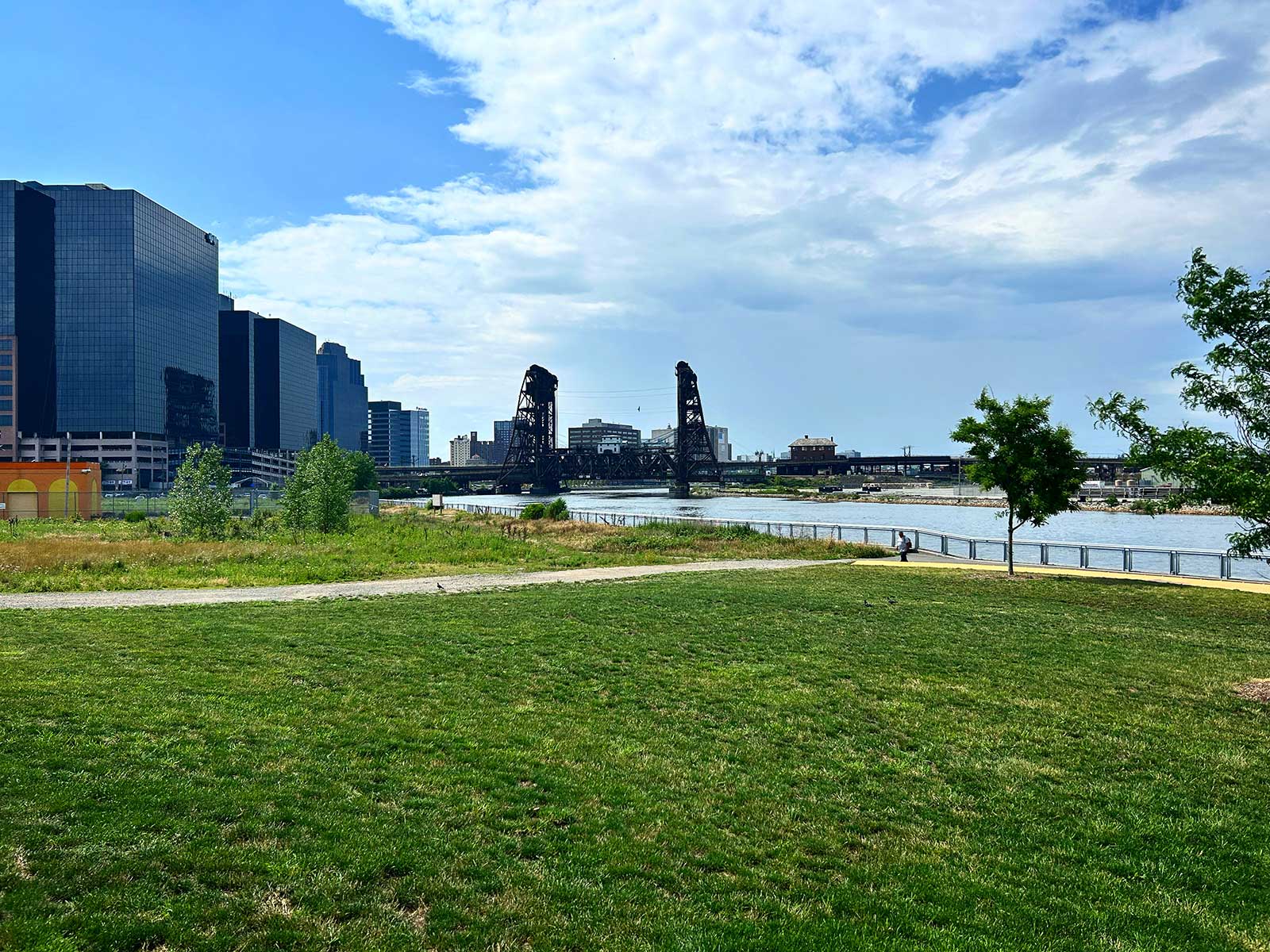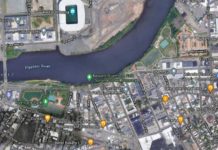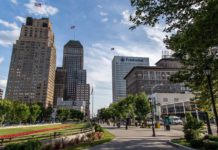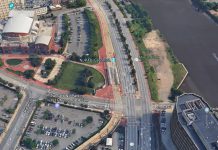
Newarkers weren’t always so estranged from the Passaic River. In the 19th century, fisheries lined the coast, winter turned the surface into an outdoor ice-skating rink, and boats and ferries sliced through the water, all documented in the Newark Public Library’s current exhibition, “Revered, Reviled, Restored.”
“If you look at some of the photos in the exhibit, people were swimming in the river as recently as the 1930s,” said Beth Zak-Cohen, who co-curated a show with Keegan Fletcher. “Clement Price said when the riverfront park opens it will connect the river back to the people.”
For decades, Newarkers have been trying to reclaim the river that pollution stole from them and make it public space. Zak-Cohen was able to find an article from 1915 that discussed turning the riverbank into a place for recreation. The latest and most successful effort began in 1996, when community activists who called themselves SPARK — an acronym for Save the Park at Riverbank — contested former Yankees catcher Rick Cerone’s plan to bring a minor league stadium to the Ironbound.
Their fight was successful. Now, the city is committed to three miles of parkland along the river. In 2012, the first of five proposed phases of Riverfront Park opened near the Terrell Homes. By 2015, two more segments had been unveiled, including the much celebrated Orange Sticks designed by Lee Weintraub.
But there has been little progress since then. In 2021, the city officials told the Friends of Riverfront Park that construction was resuming on the largest acreage of the park from Madison Street to the FBI building. The hired firm, James Corner Field Operations, the same architects behind Manhattan’s High Line, had already produced schematic designs for the entire riverfront from the Orange Sticks all the way to Bridge Street. But then suddenly construction was halted.
Jerrah Crowder, assistant director of Economic & Housing Development, said the city had parted ways with the hired construction firm after a “disagreement.” The city government also needed to buy the remaining property along the river, he said.
“There are a number of parcels along that riverfront that need to be acquired by the city,” Jerrah Crowder, assistant director of Economic & Housing Development. “We are in the process of some site acquisitions — that needs to happen in order for us to begin construction and get proper approvals.”
Perhaps the delays will prove advantageous for the Friends of Riverfront Park, who expressed disapproval with designs released for the remaining sections of the park. Nancy Zak, community activist and Zak-Cohen’s mother, said she has written three letters to City Hall — the last one sent in January this year — asking for changes to the designs: less concrete, a better network of pathways, and safer bike lanes. But the organization still hasn’t received any response in three years.
“We believe the current proposal is deeply misguided for this prime public property, and does not respond to the needs and desires of the community, who have worked tirelessly for over 25 years to realize this project,” Zak’s January letter reads.
Crowder, who has agreed to appear at the next meeting of the Friends of Riverside Park, confirmed to Jersey Digs that he is aware of the feedback from the community.
“We’re mulling it over internally,” Crowder said. “We’re looking to make the necessary refinements so that we get a park we can enjoy.”
The plot of land where Riverfront Park is being built is complicated to develop because it requires an overlap of different agencies and bureaucracies to carry out not only the planning, but also environmental remediation, wetlands mitigation, and the construction of bulkheads. The US Army Corps of Engineers is aiming to finish constructing the river wall next year, according to Jason Shea, project manager. The lower 17-miles of the Passaic is also a superfund site due to the high levels of dioxin that were buried in the riverbed.
But there is hope. Other once reviled rivers have come back from the brink of death and so will the Passaic River. A few years ago, on a boat tour in Amsterdam, I watched a Dutch tour guide dunk a glass into the water of the North Sea Canal, then raise it to her lips to drank. The tour group of mostly Americans recoiled in disgust because none of us could fathom that the closest waters to an industrialized city could ever be so clean. The canal, once used as sewer, had bounced back after a clean-up effort that began in 1987.
In 1901, Newark historian Frank Urquhart wrote about the last boat race held on the Passaic River, which could serve as the river’s obituary. “The river had become so foul it was found impossible to find young men sufficient to row the crews,” he wrote.
Perhaps Newark’s renaissance will be defined not by the height of its skyscraper but by the recreation and commerce on its waters. Brick City Rowing, founded with the belief that boating is an inner-city sport, wants to build a boat house along the river to hold races. It’s fitting, because Newark was the site of the state’s first regatta. Who knows, maybe the ferry that Ferry Street is named after will return to shuttle commuters to Paulus Hook someday?


